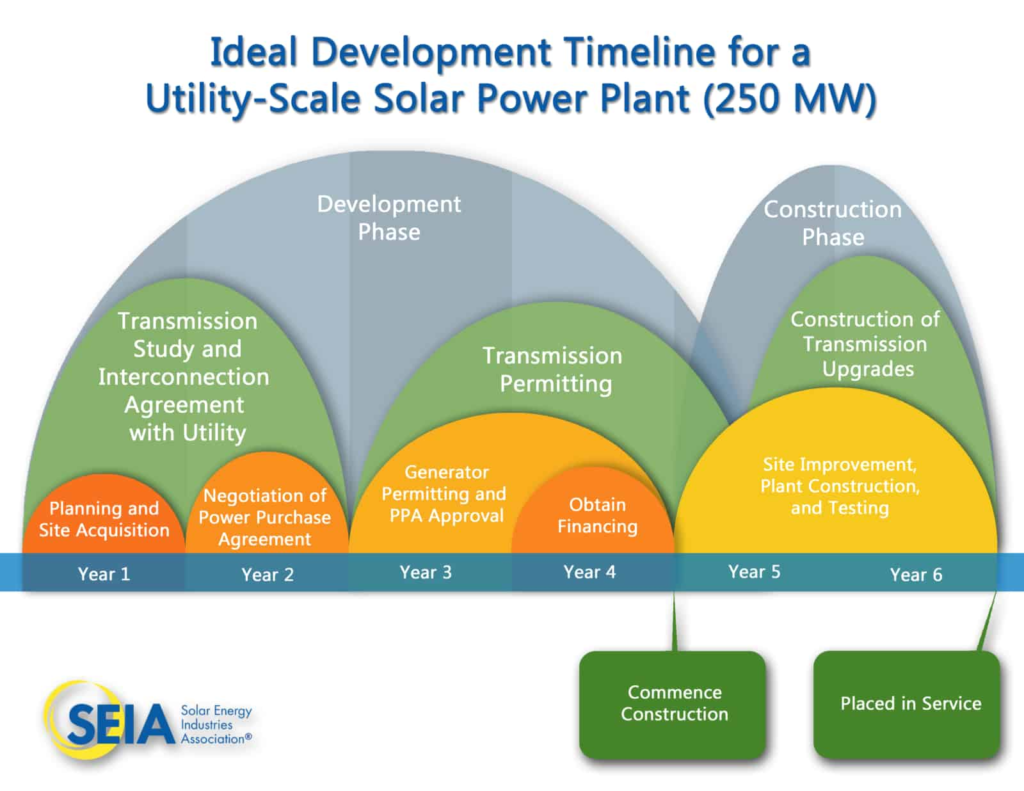(Note: portions of this article are based on information from the Solar Energy Industries Association, the national solar trade association)
Nearly 10,000 solar projects over 1 megawatt (MW) are in operation or development across the U.S. This “utility-scale” solar has been generating reliable, clean electricity with a stable fuel price for decades. Developing utility-scale solar power is an effective way for tribes to combine significant economic impact (through the sale of the electricity generated) with job creation and environmental stewardship. Nationwide, there are more than 37,000 megawatts of utility-scale solar projects currently operating, with another 112,000 MW under development as of July 2020, with projects ranging up to 100’s of MWs.
A utility-scale solar power plant can utilize several solar technologies – primary photovoltaics (PV) or concentrating solar power (CSP). What distinguishes utility-scale solar from distributed generation is both project size and the fact that the electricity is sold to wholesale utility buyers, not end-use consumers. Utility-scale solar plants provide the benefit of fixed-priced electricity during peak demand periods when electricity from fossil fuels is the most expensive.
Many utility-scale solar designs can also include energy storage capacity that provides power when the sun is not shining, and increases grid reliability and resiliency. Utility customers have repeatedly endorsed investments in utility-scale solar plants. Utility-scale solar creates jobs across the supply chain, from R&D and engineering to manufacturing and project finance to development and construction.
Development Path
Typically, after a tribal community has assessed its interest in developing commercial-scale energy, either a utility partnership and/or an agreement with a third-party qualified energy project developer are necessary initial steps. The graphic below illustrates the primary stages of developing a utility-scale solar project:

Examples
Several good examples of tribal utility-scale solar projects and development exist in the New Mexico area:
- Picuris Pueblo: In 2018, the Pueblo of Picuris installed a 1 megawatt solar PV array on reservation land. Kit Carson Electric Cooperative (KCEC) purchases the entire output of the array, and compensates the tribe by cash payment; a portion of this payment offsets tribal members bills through a direct credit to their Kit Carson electric bill. See the ESI Case Studies page for details and financing information.
- Navajo Power: As of April 2020, Navajo Power (an independent commercial energy developer seeking beneficial community economic impact) was preparing a bid to build 200 MW of solar power, after the Arizona utility Salt River Project issued a bid request specifying solar on Navajo Nation lands. The solar project selected by the utility will help make up for generation capacity lost when the coal-fired Navajo Generating Station closed; the utility will pay the Navajo Nation for the use of its transmission lines.
- Jicarilla Apache Nation: In partnership with PNM and Hecate Energy (a commercial project developer), the Jicarilla Apache Nation will host a 100 MW PV solar array that broke ground in October, 2020 on 500 acres of tribal land. The array will provide 2 megawatts of renewable energy back to the community, while the bulk of the power will be purchased at 1.9 cents per kilowatt hour and provided to anchor customers through PNM’s Solar Direct program, including the City of Albuquerque and Santa Fe County. Under PNM’s Solar Direct program, businesses, city government, educational institutions and tribal agencies can subscribe for the output of solar projects. Rio Arriba County enabled issuance of an Industrial Revenue Bond for Hecate Energy as part of the financing package. When complete, this will be the third largest solar project on tribal land in the U.S.
Economic Factors
Utility-scale projects can generally be implemented with little or no out-of-pocket expense for the hosting tribe that provides the site. That said, solar projects require substantial amounts of acreage on which to build the PV array. Depending on the specific technology, a utility-scale solar power plant may require between 5 and 10 acres per megawatt of generating capacity, and requires some grading of land and clearing of vegetation. In addition, adequate transmission capacity must exist (or be built) to transport the energy from the project site to its customers. Major funding sources include:
- Third-party commercial developers will typically invest much or all of the funding needed
- Power Purchase Agreements (PPAs) with the utility serving the tribe (or in some cases elsewhere if the power is transported) ensures a steady income stream over a long period of time
- A utility is typically a partner in the project’s development, with a PPA in place as part of the financing structure; utilities will also issue occasional RFPs for renewable energy acquisition (see Navajo Power and Jicarilla Apache Nation projects above)
See also the ESI Funding Resources page for more information.


